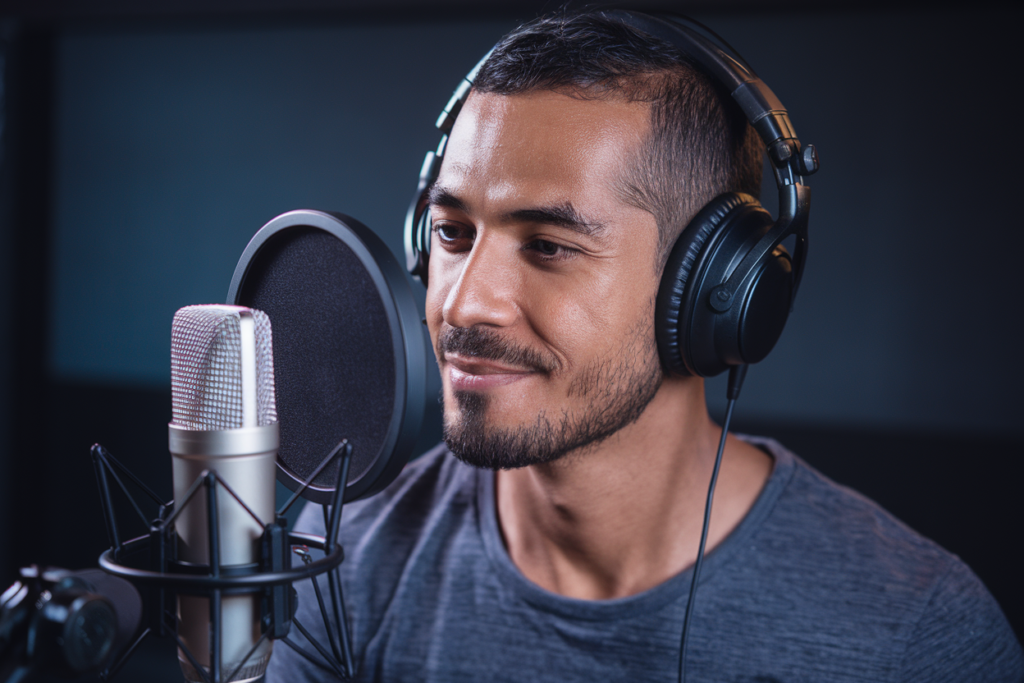Key Takeaways
- Importance of Standard Pronunciation: Standard pronunciation is essential in Arabic dubbing for clarity and consistency, ensuring that audiences can fully engage with the content.
- Cultural Inclusivity: Mastering standard pronunciation helps bridge dialectal differences, making media accessible to diverse viewers while preserving cultural integrity.
- Audience Engagement: Properly pronounced dialogue enhances comprehension and emotional connection, boosting viewer loyalty and encouraging repeat viewership.
- Challenges in Dubbing: Voice actors face challenges such as regional dialect variations and technical limitations that impact achieving standard pronunciation during the dubbing process.
- Techniques for Success: Effective voice training and careful script adaptation are key techniques to maintain standard pronunciation while respecting regional nuances.
- Economic Impact: Prioritizing standard pronunciation can lead to increased profitability by attracting broader audiences and reducing localization costs.
Ever wondered why some Arabic dubbing sounds smoother and more authentic than others? Standard pronunciation in Arabic dubbing plays a crucial role in making content relatable and enjoyable for viewers. When done right, it enhances comprehension and keeps audiences engaged.
In a world where media transcends borders, mastering standard pronunciation can be the difference between captivating your audience or losing them. Whether you’re a voice actor, director, or simply curious about the art of dubbing, understanding these nuances is essential. Let’s dive into how standard pronunciation shapes Arabic dubbing and why it matters now more than ever.
Overview of Arabic Dubbing
Arabic dubbing plays a crucial role in the accessibility and enjoyment of media across the Arab world. It involves replacing original dialogue with Arabic voices, allowing viewers to connect better with content, whether it’s animated films, series, or documentaries. When you think about how many people consume media daily, effective dubbing becomes essential for comprehension and engagement.
Standard pronunciation is vital in this process. Voice actors must deliver lines with clarity and accuracy. This ensures that the intended message resonates with audiences from different regions who might have varying dialects. Consistent pronunciation helps create a unified voice that enhances the viewer’s experience.
Voice artists bring characters to life through their performances. Each voice talent has a unique style, but they all share a common goal: to convey emotions authentically while staying true to the original material. The choice of voice over talent can significantly impact how well an audience relates to a character or story.
In recent years, technological advancements have transformed Arabic dubbing techniques. High-quality recording equipment and software enable voice over actors to produce clearer soundscapes that mirror live performances more closely than ever before. This technology allows directors greater flexibility during production and contributes to polished final products.
As you consider engaging voice over services for your projects, it’s essential to prioritize standard pronunciation among potential talent options. A skilled voice actor will not only meet these standards but also add depth and personality to your content—making it memorable for audiences across various demographics.
Ultimately, understanding the intricacies of Arabic dubbing equips you with valuable insights into creating relatable content that captivates viewers’ attention effectively.
Importance of Standard Pronunciation
Standard pronunciation plays a crucial role in Arabic dubbing. It ensures clarity and consistency, allowing viewers to fully immerse themselves in the content. When voice actors deliver lines with precise pronunciation, they create an authentic connection between the characters and the audience.
Cultural Significance
Cultural nuances shape how language is perceived. In Arabic-speaking regions, standard pronunciation bridges dialectal differences, making media accessible to diverse audiences. It fosters inclusivity, as viewers from various backgrounds can understand and engage with the material without confusion. Voice artists who master standard pronunciation help preserve cultural integrity while broadening reach.
Impact on Audience Reception
Audience reception hinges on clarity and relatability. Properly pronounced dialogue enhances comprehension, ensuring that key messages resonate with viewers. When voice over talent delivers lines accurately, it boosts engagement and emotional response. This connection strengthens viewer loyalty and encourages repeat viewership across different platforms.
Prioritizing standard pronunciation elevates the quality of Arabic dubbing, enriching both cultural significance and audience experience.
Challenges in Achieving Standard Pronunciation
Achieving standard pronunciation in Arabic dubbing presents several challenges that can affect the overall quality of voiceovers. Understanding these obstacles helps ensure effective communication and enhances audience engagement.
Regional Dialects
Arabic consists of numerous regional dialects, each with distinct phonetic nuances and vocabulary. This diversity poses a challenge for voice actors who must navigate various pronunciations while striving for consistency in their performances. For instance, a phrase pronounced one way in Egypt might differ significantly from its pronunciation in Lebanon. Voice artists need to master these variations to maintain clarity without alienating specific audiences. When dubbing content intended for a broad audience, striking the right balance between standard pronunciation and local dialects becomes essential.
Technical Limitations
Technical limitations also impact achieving standard pronunciation during the dubbing process. Sound equipment quality can influence how clearly voice talents deliver their lines. Poor acoustics or subpar microphones may distort sounds, making it difficult for viewers to understand dialogue properly. Additionally, timing issues during synchronization can lead to mispronunciations as voiceovers attempt to match lip movements on-screen. Voice over talent must adapt quickly to overcome these technical hurdles while ensuring their delivery remains authentic and engaging.
Recognizing these challenges allows creators to prioritize training and resources that enhance both the quality of dubbing performances and the effectiveness of communication across diverse audiences.
Techniques for Maintaining Standard Pronunciation
Maintaining standard pronunciation in Arabic dubbing involves various techniques that enhance clarity and engagement. These methods ensure voice actors deliver their lines accurately, resonating with diverse audiences.
Voice Training
Voice training is essential for voice actors aiming to achieve standard pronunciation. Regular practice helps artists develop vocal control and articulation skills. Techniques like breathing exercises strengthen the diaphragm, enhancing vocal projection. Additionally, working with a coach can refine pronunciation nuances specific to Arabic phonetics. Engaging in consistent feedback sessions allows voice talent to identify areas for improvement, ensuring they master the intricacies of the language.
Script Adaptation
Script adaptation plays a crucial role in maintaining standard pronunciation while respecting regional dialects. Adapting scripts involves selecting terminology that aligns with neutral Arabic without losing cultural context. This approach allows voice artists to deliver lines authentically while minimizing mispronunciations caused by local variations. Collaborating closely with directors ensures the adapted script meets both artistic intent and linguistic accuracy, providing a seamless viewing experience for audiences across different regions.
Impact on the Industry
Standard pronunciation in Arabic dubbing significantly impacts the industry by shaping audience perception and engagement. Proper pronunciation enhances clarity, making content accessible to diverse viewers across different regions. When voice actors deliver lines accurately, they create a unified experience that resonates with audiences, fostering emotional connection.
Economic Considerations
Economic factors play a crucial role in the importance of standard pronunciation. Content creators recognize that clear delivery attracts broader audiences, which can lead to increased viewership and revenue streams. When productions prioritize voice talent who excel in standard pronunciation, they minimize localization costs associated with re-dubbing or extensive editing for various dialects. This efficiency translates to greater profitability while maintaining high-quality standards.
Influence on Localization
Standard pronunciation also influences localization processes within Arabic dubbing. A consistent phonetic approach simplifies translation efforts and ensures dialogues align seamlessly across different media formats. By employing voice artists skilled in standard pronunciation, projects benefit from smoother adaptations that respect linguistic diversity without sacrificing authenticity. Ultimately, this practice supports cohesive storytelling that captivates viewers regardless of their regional backgrounds.
Conclusion
Mastering standard pronunciation in Arabic dubbing isn’t just about clear speech; it’s a vital ingredient for engaging storytelling. When voice actors deliver lines with precision, it enhances audience connection and comprehension across diverse regions. This consistency fosters loyalty among viewers who appreciate high-quality productions.
As the industry evolves, embracing training techniques and collaboration will only improve the art of dubbing. By prioritizing standard pronunciation, you’ll contribute to a richer viewing experience that resonates deeply with audiences everywhere. Balancing regional nuances while maintaining clarity not only strengthens your projects but also elevates the entire Arabic dubbing landscape.
Frequently Asked Questions
What is the importance of standard pronunciation in Arabic dubbing?
Standard pronunciation is crucial in Arabic dubbing as it enhances comprehension and audience engagement. It ensures that content is relatable and enjoyable, allowing viewers from various regions to connect with the material effectively.
How does proper pronunciation impact viewer experience?
Proper pronunciation improves clarity, making dialogues easier to understand. This fosters emotional connections between the audience and characters, ultimately enhancing viewer loyalty and encouraging repeat viewership.
What challenges do voice actors face regarding pronunciation?
Voice actors often navigate regional dialects that present phonetic differences. Mastering these nuances while maintaining a consistent standard pronunciation can be challenging but essential for resonating with diverse audiences.
How can voice training improve Arabic dubbing?
Voice training helps refine specific phonetics related to Arabic language nuances. Regular practice, breathing exercises, and coaching enhance delivery accuracy, contributing to higher quality dubbing performances.
Why is script adaptation important in Arabic dubbing?
Script adaptation balances standard pronunciation with regional dialects. It aligns terminology with neutral Arabic while respecting cultural context, ensuring that dialogues maintain both linguistic accuracy and artistic intent.
How do technological advancements affect Arabic dubbing quality?
Technological advancements have improved sound clarity and production flexibility in Arabic dubbing. These innovations help voice artists deliver lines more accurately, enhancing overall viewer experience through better audio quality.
What economic benefits arise from prioritizing standard pronunciation?
Prioritizing standard pronunciation minimizes localization costs associated with re-dubbing or extensive editing for different dialects. This approach leads to broader audience reach, increased viewership, and greater profitability for productions.
How does standard pronunciation aid localization processes in media?
A consistent phonetic approach simplifies translation efforts across various media formats. Skilled voice artists ensure that dialogues align seamlessly, supporting cohesive storytelling regardless of regional backgrounds among viewers.







